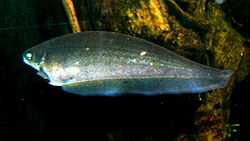Xenomystus nigri
| African Knife Fish | |
|---|---|
 | |
| Scientific classification | |
| Kingdom: | Animalia |
| Phylum: | Chordata |
| Order: | Osteoglossiformes |
| Family: | Notopteridae |
| Genus: | Xenomystus Günther, 1868 |
| Species: | X. nigri |
| Binomial name | |
| Xenomystus nigri (Günther, 1868) | |
Xenomystus nigri, the African Brown Knife Fish or African Knife Fish, is the only species in the genus Xenomystus of the family Notopteridae. This fish inhabits coastal river basins in Sierra Leone, Liberia, Togo, Benin and Cameroon. It also in Chad, the Nile, the Congo, and the Niger basins.[1]
Anatomy and appearance
This fish reaches 30 centimetres (12 in) SL in length.[1] The body of these fish is unusual, with the body ventrolaterally flattened and elongated, giving the appearance of a knife blade. The caudal and anal fins are fused and run from beneath the gill opening to the pointed end of the body, creating a uniform, skirtlike fin. This appendage gives the animal superior control in the water, as it is able to propel itself forward and backward with a minimum of wasted energy. The pelvic fins are extremely reduced and are not used in locomotion. The dorsal fin is absent. The pectoral fins of the African brown knife fish are lengthy and designed to give the animal precise control as it swims. They are often employed in a windmilling motion, in conjunction with the caudal/anal fin, as the fish retreats into its lair.
The scales of the knife fish are extremely small, giving the fish a smooth appearance broken only by its fairly prominent lateral line. Apart from its eyes, the lateral line is the knife fish's most important sensory apparatus. The African brown knife fish is nocturnal and uses the nerve-filled pits running down its body to navigate lightless waters. In addition, the eyes of this fish are large in relation to its body size. They provide the animal with excellent night vision.
The mouth is large, and the fish also possesses a pair of short barbels used in hunting. The knife fish, when not hiding away, spends much of its time swimming with its head down and the barbels in close proximity with the substrate. Combined with its acute eyes, the barbels aid the fish in locating its food.
Ecology
This fish preferes quiet water with vegetation. Females lay 150–200 eggs of 2 millimetres (0.08 in) in diameter. This species of fish can produce barking sounds. These fish will come to the surface from time to time to swallow air. They feed at dusk and during the night on worms, crustaceans, insects and snails.[1]
In the aquarium
This species is sometimes available as an aquarium fish, and has been popular in the hobby for a long time.[2] Because this fish is primarily nocturnal, it will retreat from brightness in the aquarium. When larger, these fish may prey upon smaller tankmates [2] as these fish have relatively large mouths for their size.
Social Behavior
This fish does well when kept in small groups when young, although as it ages, will become somewhat aggressive towards those of its own kind. The African knife should not be thought as aggressive as other knife fish, such as the black ghost, and can coexist with those of its kind into old age when allowed about 75 gallons per knife. And unlike that of the Black Ghost Knife, the African Knife will accept flake food, especially when there are other knives present to compete with.
See also
References
- ↑ 1.0 1.1 1.2 Froese, Rainer and Pauly, Daniel, eds. (2007). "Xenomystus nigri" in FishBase. Apr 2007 version.
- ↑ 2.0 2.1 Axelrod, Herbert, R. (1996). Exotic Tropical Fishes. T.F.H. Publications. ISBN 0-87666-543-1.
- Innes, Dr William T. Exotic Aquarium Fishes, 19th edition, Innes Publishing Co. Philadelphia, 1956.